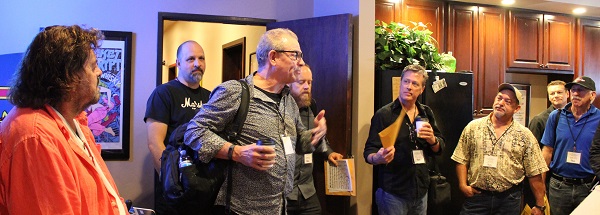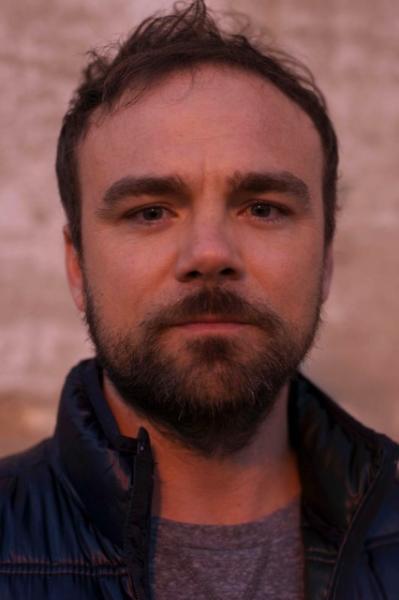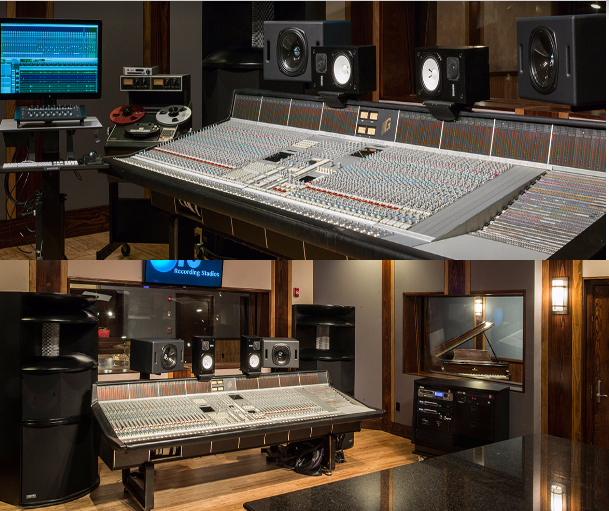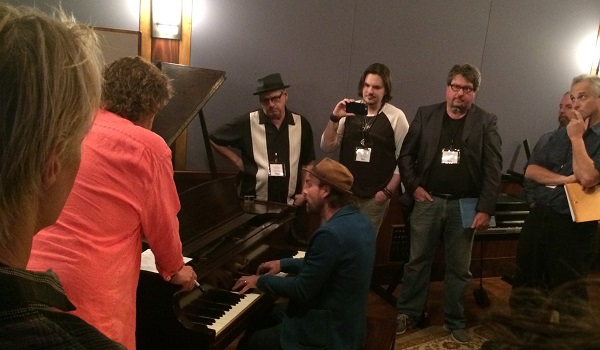MCTS Austin
Recording Rock in Austin: Live Music Capital of the World


MCTS Chicago
Date: November 15 2016
Country: USA
Venue: Orb Studios
Event: MCTS Level 2
Artist: Casey McPherson
Engineer And Producer: Alan Parsons
Event Manager Charlie Steves
Assistant Engineer Robert Sewell
Event Producer: Julian Colbeck for KEYFAX NewMedia.
Overview‘Live Music Capital’ Austin—may be the blue dot in a red state but it’s still very much Texas. It’s hot, people wear cowboy hats and sport an amiable southern drawl, they make s*&*-kickin’ BBQ and all that good type of stuff. They also breed great independent-minded musicians, who are trying the fight their way through the haze and maze of life on-line—with all the many challenges and opportunities that brings. Native son Casey McPherson assembled a fine posse of young guns for the Austin master class: a pair of pedal-laden guitar slingers, a pair of pedal-laden keyboardists, a bassist, a splendidly inventive drummer who not played an intriguing kit, he also built it too, and a dedicated backing vocalist who specializes in Beach Boys harmonies. “The high or low voices?” we asked Casey. “All of them,” he fired back. The master class got under at 10 sharp with the customary round of everyone having 30 seconds to introduce themselves. This was a classic MCTS mix of studio owners, tech CEOs, producers, young musicians (one coming from as far as Sao Paulo), church music directors, entrepreneurs… an airline pilot embarking on a studio-building project… Everyone had a mission, a purpose and a song in their heart. Casey McPherson has some deep prog rock roots and his song White Matter Recess bustles with bars of 2/4 and 7/8 while remaining hooky and catchy. But a little long, Alan felt, for the job in hand. Soon he and Alan were at the piano; attendees gathered around like anxious relatives at a birth as the arrangement tightened and got more to the point quicker. So often nowadays songs are arranged, if not pretty much written, in ProTools. It seems a quick and sensible route, but is it? Is that how Yes would have ended up with Close To The Edge? Almost certainly, not. (Speaking of which, Jon Anderson was in town, playing the night before with Rick Wakeman and Trevor Rabin at the Moody Theater. A hasty email to Jon elicited a good luck, sorry to miss you but we’re already en route to Denver.)
And so the Austin session began in earnest with drummer Tabber Millard explaining his unique hand-built and ballsy sounding kit, complete with an alternate kick drum and wafer thin second share (that he mainly uses for hip hop and breakbeats). With six musicians on the live tracking session and a full crowd of attendees interested in all aspects of micing it took awhile to get everything set up and in fact an early lunch was taken before tape (metaphorically) was rolling. As the day progressed through tracking, guitar and keyboard overdubs to vocals—Casey impressing all concerned with his technical chops and emotional range from full voice to falsetto (Alan used a Neumann look/sound-alike Bock 47—"very nice," he said afterwards—on the lead vocal)—the clock also ticked relentlessly. Come 7PM, a time when normally the session would be well into a mix, backing vocalist Brandon Kinder (known, with Justin Wiseman from "The Rocket Boys") was still in full flight. Alan called timeout to do certificate signing and photos as several attendees had cars if not flights pending. But at 8.30 the relentless Parsons, flanked by a die-hard delegation of attendees, snuck back in the control room to complete a punchy mix. And so ended a memorable almost 12-hour session—almost certainly a record for MCTS events.
| A Life In The Day What it’s like working in the studio with Alan Parsons The key ingredient in any Master Class is hang time with the Master. Not hang time in terms of swapping jokes or sharing the peanuts but considered, observational hang time where you’re able to pick up on the vibe, the pacing, the approach to the day’s proceedings. These days it can seem everyone has the same information available to them and to some extent we have. How to mic a snare (“use a 57”), how to record upright piano (“point a pair of AKG C12’s at the back from a foot and half away”) but exactly where to point the 57 on ‘this’ snare, how much stereo to shoot for on the upright are the details on which the devil bases almost all his levels of success. The beauty of MCTS events is that there’s time and opportunity to ask and get answers, to live and learn. And also to contribute. Validation is often quoted as one of the most valuable take-aways from an MCTS. “I was just going to suggest a little boost at 12k” said one Attendee. “And then Alan comes up and says ‘I think we need a little more at 12k’ and I was like YES!” Hearing can sometimes just be believing in yourself. At the other end of the spectrum are those “You’re right but I’d never have thought of that” moments like when Alan stunned a session in Buenos Aires by physically EQ-ing the left and right overheads and not simply ‘copying’ left and right settings and reminding them: “Recording is about how it sounds, not about how it looks.” MCTS events are both hands-on and feet on the ground affairs. In fact knees on the ground as often as not. Alan is not averse to plonking himself down n the floor to nudge a mic a half an inch to the right so that it’ll escape the worst of the spill from a neighboring sound source. There will be many moments in an AP session where the muse and the magic starts to flow. Often you’ve got to be quick and really pay attention to ‘what just happened’. Alan is not going to bang a gong (literally or figuratively) and either telegraph every move he’s making or make some big deal of it after. So much of what makes a great producer or engineer is taste and instinct that the observer needs to keep their wits about them in order to distill a particular moment into tangible lesson form. Much of what Alan Parsons is all about he learned at Abbey Road, be it overarching concepts like ‘value for money’ or the particular such as miking a concert Grand piano. At all levels, benefiting from Alan‘s lifetime of experience in such a short space of time is an exhausting and exhilarating experience for everyone involved. |
The Artist

Austin-based singer/songwriter Casey McPherson is a Texas native whose career has encompassed all forms of rock—progressive with the prog rock supergroup Flying Colors (alongside Steve Morse, Mike Portnoy and Dave LaRue), hard rock and alternative rock with his own band Alpha Rev whose major label album New Morning was produced by Grammy-winning producer David Kahne.
McPherson’s voice is a classic rock one; distinctive and original but with the same energy and power of a Phil Collins or a Paul Carrack. McPherson also brings a highly trained (classical piano) instrumentalist’s ear and mindset to his songs and arrangements.
A bird’s eye view of the Austin session will shortly be available on Casey McPherson’s blogsite www.casesessions.com in his series of documentary+music file offerings entitled "cas.e sessions." Here, you’ll be able to download the song plus view an accompanying documentary for a monthly membership of $5.99 (as Casey puts it, for the price of a latte) for on-going access to the musings and music of this compelling and multi-faceted artist.
Additional musicians on the session included:
Drums: Tabber Millard
Bass: Robin Mordecai
Guitar: Zak Loy
Guitar: Wes Ardis
Synths: Justin Wiseman
Backing Vocals: Brandon Kinder
The Venue
Orb Studios, 9306 Ledgestone Terrace, Austin TX 78737
Phone: 512-433- 6301
Premier Austin studio Orb Studios is part owned and run by members of the band Blue October, who worked with Alan Parsons on a TV project a number of years ago.
The 5600 sq. ft. facility was revamped in 2015 using Mark Genfan, owner and chief designer at Acoustic Spaces. Genfan enlisted the help of John Calder from Acoustic Geometry ™ , a company offering best-in- class acoustic products for a wide range of professional audio, residential and business applications. Acoustic Geometry provided its Curve Diffusors to round out the acoustic profile of Orb Studio’s control rooms.
Notable clients range from Third Eye Blind to rapper Lil’ Wayne, Orb Recording Studios is dedicated to enhancing every client’s creativity by providing a positive, inspiring and stress-free professional environment. The facility features two large, hardwood floating-floor recording studios capable of accommodating any number of players from a solo artist to an orchestra.
Studio A comprises a 672 sq. ft. live room with 20-foot ceilings and floating hardwood floors and a 336 sq. ft. piano room equipped with a 1938 Steinway Baby Grand Piano and a 1957 Hammond B3 Organ. The control room boasts a 48 channel SSL 6048 E|G+ console, a Studer A827 2" Tape Machine, Pro Tools 11 HD, and a rare set of Allen Sides Ocean Way Audio HR2 monitors, supported by Genelec 1037s and of course Yamaha NS10s. In the cabinet is an excellent selection of vintage and modern mics, and similarly expansive collection of mic pres (vintage Neve 1073's, Vintech 73i, Universal Audio 2-610S, BAE 1084's, Shadow Hills Industries Quad GAMA with Iron Modification, API 512C's, Tonelux MP5A Modules), EQs and compressors.

Orb Studios is situated in the Oakhill suburb of Austin, approximately 15 minutes from downtown and 25 minutes from Austin-Bergstrom airport. Hampton Inn is the nearest major hotel (5 miles) and we hope to be announcing some special pricing on accommodation shortly.
Tickets
SOLD OUT Platinum: $1000 US Dollars (includes meals and refreshments throughout the day)
Platinum ticket holders attended the workshop in the main control room with Alan. Each will receive:
- A signed Certificate of Completion personally presented by Alan Parsons at the end of the workshop.
- Choice of a signed copy of Alan Parsons’ Art & Science Of Sound Recording – The Book, or DVD set.
- Ticket to the Champagne Reception.
Schedule
- 09.30–10.00 Welcome, Registration. Coffee and pastries will be served.
- 10.00–10.30 Alan Parsons introduces the musicians and sets goals for the session.
- 10.45–11.45 Micing the drums and placement of other instruments for initial tracking.
- 11.45-1.00 Tracking session with drums, bass, guitar, keyboards and guide vocals.
- 1.00-2.00Lunch with Alan and performers at the studio.
- 2.00-4.15 Instrumental overdubs (keyboards, guitar, violins)
- 4.15-4.30 Break.
- 4.30-6.30 Lead and backing vocal recording.
- 6.30–7.00 Q&A with Alan Parsons
- 7.30 Champagne Reception at the studio
All enquiries to info@artandscienceofsound.com or to KEYFAX NewMedia on 1-800-752-2780
Alan Parsons' Art and Science of Sound Recording | Promote Your Page Too


